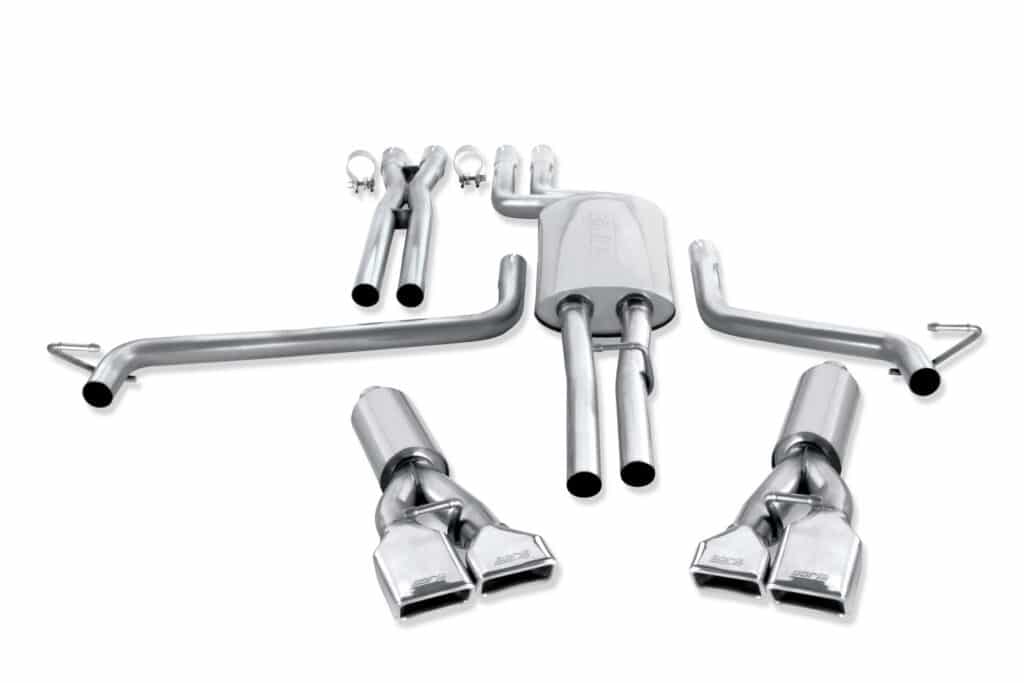Most people have heard of an exhaust system but what they don’t know is exactly what it does. Some know that it helps the engine sound better, and that’s all.
While this is not wrong, it is only a tiny bit of what exhaust systems do.
Exhaust systems also do other tasks, from collecting the exhaust gases through the exhaust manifold to the point where it releases the gases out into the environment.
This makes the exhaust very crucial to the performance of your engine and vehicle as a whole.
To perform all these tasks, exhaust systems are usually made up of different components.
These components include:
- Exhaust manifold (sometimes swapped with exhaust headers)
- Muffler
- Catalytic converter
- Oxygen sensor
- Exhaust pipes and tubing
- Resonator
All these components collaboratively work together.
Each contributes a major part to the performance and functionality expected from every exhaust system.
To integrate all these components, a piping system is used to connect one to the other.
Uses of an exhaust system:
- Carry away harmful exhaust gases
- Enhance the power and acceleration of the engine
- Improve fuel consumption
- Noise control
- Eliminate bad smells
Signs that your exhaust system is faulty:
- Smell of gas
- A burning smell
- Overly loud and obnoxious engine noise
- Hissing sound
- Rattling and dragging noises
- Decreased acceleration power
- Poor fuel efficiency
Uses of an exhaust system
1. Carry away harmful exhaust gases
As your engine is running, there are several exhaust gases that are produced. Some of these gases are harmful both to the occupants of the car and the engine.
They include Nitrogen Oxide, Carbon Monoxide, and other hydrocarbons.
The gases are usually very toxic, corrosive, and hot. If left in the engine, they can cause it to blow as well as be harmful to anyone in the vehicle. Similarly, if released into the environment, they will cause harm.
To counter this, the exhaust system converts the exhaust gases into less toxic gases and cools them down before releasing them out of the vehicle through the tailpipe.
The process includes the exhaust gases being released from the combustion box and deposited into the exhaust cylinder.
They then flow through the exhaust pipes and finally collected by the exhaust manifold. The exhaust manifold channels them into the catalytic convertor.
In the catalytic converter, the gases go through chemical reactions in which they turn into carbon dioxide and water vapor, which are not harmful to the environment.
Because of this, the catalytic converter is one of the most important parts of an exhaust system. It is also the most expensive part.
2. Enhance the power and acceleration of the engine
As the exhaust gases exit your engine into the exhaust system, the flow of air in your engine and combustion box is improved.
This means the engine will be able to take in more oxygen and maintain better performance.
Also, with the help of the oxygen sensor, the engine will take in the right amount of oxygen and this will improve the performance a great deal.
If you need your car to move even faster, you may need to have your exhaust system upgraded to a performance exhaust system. This has many benefits but the main one is an increase in horsepower.
3. Improve fuel consumption
As mentioned earlier, the exhaust gases come out through the exhaust pipes into the exhaust manifold then pass through the oxygen sensor. The sensor will test the amount of oxygen that is in the gases.
With modern vehicles, the information is relayed to the vehicle’s computer which adjusts the amount of fuel taken accordingly.
This ensures that the engine does not take too much oxygen that goes to waste, as well as ensure it takes only as much as is needed.
Every vehicle model has a different design of oxygen sensors and the number could vary between one to five, with most having two.
The oxygen sensor also helps identify whether or not the catalytic converter is functioning properly.
4. Noise control
It is very easy to spot a car with a faulty or low-performance exhaust system, or one that does not have a muffler or whose muffler is faulty.
They are usually annoyingly loud and you can hear them from miles away. This is not only annoying but also illegal.
On that note, it is important to know that there are legal levels of growling that are acceptable on the streets and off-road. Racing cars are an exception.
The exhaust system, through the muffler, converts the noises produced by the engine to acceptable levels.
But another thing, some people love it when their car exhaust systems produce deep and aggressive sounds, especially for the sporty ones.
To meet these needs, manufacturers of high-end and high-performance sporty cars usually include two mufflers.
One of them, which is usually the bigger one, focuses on reducing the noise while the other smaller muffler focuses on shaping it to become strong and sporty but not annoying.
Like the one shown in the video, this is an example of a healthy aggressive sound for an exhaust system.
Interestingly, you do not have to have a sporty car in order to get a sporty sound. With the right exhaust system, you can get the sound you want.
5. Eliminate bad smells
These gases are not only toxic but also have a very strong and bad smell. If released into the environment it will definitely pollute the air.
But after being converted into less toxic gases, even the smell will reduce.
Signs that your exhaust system is faulty
1. Smell of gas
When inside your car, you should not be able to smell any gas from the engine. But sometimes this happens and it is when an exhaust pipe or port is damaged and is leaking.
The fumes from the gasoline escape through the tiny openings on the leaking exhaust pipe.
If the emissions are from the exhaust system and out into the air and not into the cabin, then the problem could be with the catalytic converter.
This means that it has failed to convert the toxic exhaust gases into harmless ones.
2. A burning smell
If the damage also happens on the gasket and it starts leaking near any area made of plastic, the hot gas will burn the plastic parts, hence the burning smell.
In some extreme instances, you will also start noticing smoke.
It is important that immediately you start having the smells, you should take your vehicle to be checked. Serious damages could force you to replace the whole exhaust system.
3. Overly loud and obnoxious engine noise
The muffler is responsible for controlling and shaping the exhaust system sound waves. But before the loud exhaust noises flow to the muffler, it passes through a chamber.
This chamber is called the resonator, and it prepares the engine noise before it is silenced by the muffler.
If either of these two is worn out or is damaged, then they will not be able to do perform their task.
As a result, the exhaust system will produce a loud, obnoxious, and annoying noise that you can hear from miles away.
But remember, there are vehicles that are intentionally modified to give a loud, deep, and aggressive growling sound.
An example is in the one in the video. There is a difference between this and the loud and obnoxious noise made by a faulty exhaust system.
4. Hissing sound
While the overly loud noise is from a worn-out muffler, the hissing sound is from a damaged gasket. This hissing is caused by gas that is leaking out through tiny openings on the gasket.
5. Rattling and dragging noises
This is more of a mechanical problem and not a system problem. The rattling and dragging can be caused by a tailpipe that has snapped out of place and is hanging on the ground as you drive. It could also be any other exhaust piping that has snapped out.
6. Decreased acceleration power
Noise and smell emissions are not the only signs of a leak in the exhaust systems. A decrease in performance and acceleration is also another sign to watch out for.
If you notice you need to use more energy and effort in starting your engine, then your exhaust system could be having a problem. Reduced speed and trouble with acceleration is also another sign.
7. Poor fuel efficiency
When your exhaust system is failing, the engine has to work hard to start the vehicle and accelerate. While doing this, more fuel is burnt. You will then start noticing that you cover fewer miles than you used to before with the same amount of fuel.
This can be hard to notice easily unless you are keen on your mileage.
All these signs are different and vary in severity. But the longer you wait the longer the damage gets worse and you may end up installing a whole new exhaust system.
So, if you start noticing any of these signs, it may be time to repair the exhaust system or the specific part which is faulty.
There are two main categories of exhaust systems. The factory or stock exhaust system and the aftermarket exhaust system.
The stock exhaust system usually comes with the vehicle when you purchase it.
The aftermarket exhaust systems, on the other hand, are usually made by manufacturers other than the vehicle’s manufacturer.
Most of the time they are an upgrade of the stock systems and they have better performance.
Also something worth mentioning, a regular car usually has two tail pipes. But a sports racing car can have several.
Additionally, for a sports racing car, it is normal to see smoke and fumes coming from the exhaust system. This is not necessarily a sign of a faulty component and neither is its aggressive growling. Such cars have several modifications hence the high performance and power


